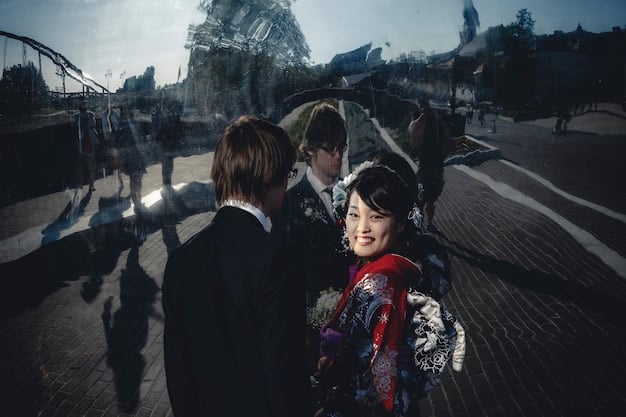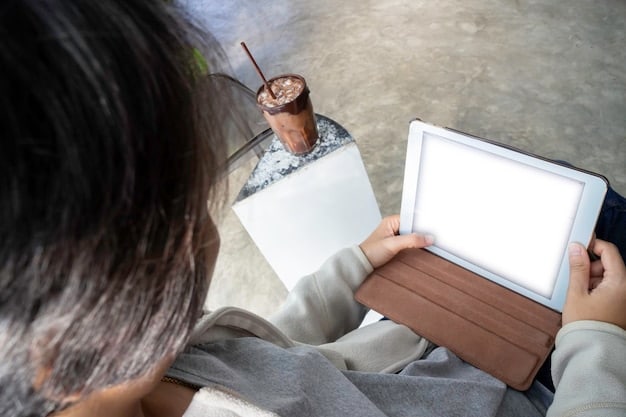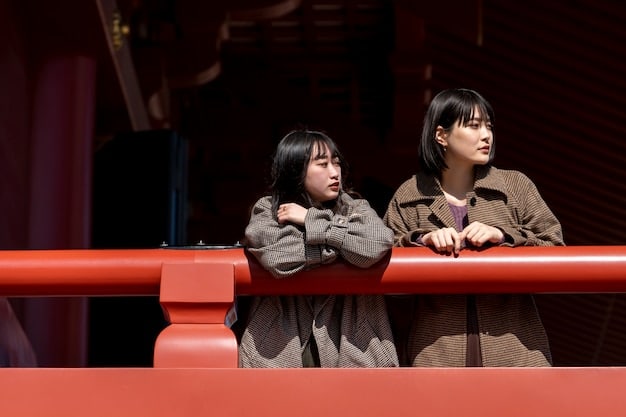Korean Drama Dialogue: Master 10 Essential Phrases for Everyday Use

Unlock the world of Korean dramas by learning 10 essential phrases for everyday use, enhancing your viewing experience and providing a practical foundation for basic communication in Korean.
Do you find yourself captivated by the world of Korean dramas but struggle to understand the nuances of the language? Learning key phrases from K-dramas can be a fantastic way to immerse yourself and even begin your journey into speaking Korean. Let’s explore how to use Korean drama dialogue: Learn 10 essential phrases for everyday use.
Why Learn Korean Through Dramas?
Korean dramas, or K-dramas, have become a global phenomenon, offering captivating storylines, complex characters, and a glimpse into Korean culture. While watching K-dramas is entertaining, it also provides an engaging way to learn the Korean language. The dialogues in these dramas offer practical phrases used in everyday conversations, making it a relevant and enjoyable learning tool.
Learning through dramas provides several advantages over traditional methods. You get to hear natural speech patterns, learn cultural nuances, and understand the context in which certain phrases are used. This immersive experience makes learning more effective and interesting.
Benefits of Learning Through Dramas
Here are some specific benefits of learning Korean through K-dramas:
- Real-Life Application: The phrases used are often taken directly from everyday Korean conversations.
- Contextual Understanding: You learn how and when to use specific phrases.
- Improved Listening Skills: You become familiar with the rhythm, intonation, and pronunciation of Korean.
- Cultural Insight: Dramas expose you to Korean customs, etiquette, and social norms.
By combining entertainment with education, learning Korean through dramas can turn what feels like leisure time into a productive language-learning opportunity.

1. “Annyeonghaseyo” (안녕하세요) – Hello
“Annyeonghaseyo” is arguably the most well-known Korean greeting. It’s a polite and versatile phrase that can be used in most situations. Understanding how and when to use it is the first step in engaging in basic Korean conversation.
This phrase is a staple in Korean dramas, often heard in formal settings or when meeting someone for the first time. Its widespread use and easy pronunciation make it an excellent starting point for learners.
Usage and Variations
- Formal Greeting: Use “Annyeonghaseyo” when addressing elders or people in positions of authority.
- Informal Greeting: A more casual version, “Annyeong” (안녕), is used among close friends and family.
- Polite Tone: Make sure to maintain a respectful tone and posture while speaking.
Mastering this simple greeting will give you confidence in beginning your Korean language journey. It’s a building block for further conversation.
2. “Gamsahamnida” (감사합니다) – Thank You
“Gamsahamnida” is the standard way to say “thank you” in Korean. It’s a formal and respectful phrase that is essential for showing gratitude in various situations. This phrase is frequently used in K-dramas as characters express appreciation.
Like “Annyeonghaseyo,” “Gamsahamnida” is appropriate in professional and polite settings. Knowing how to express gratitude is crucial in any language, and Korean is no exception.
Alternatives and Usage
- Informal Thanks: For close friends, you can use “Gomawo” (고마워), which is more casual.
- Very Formal Thanks: Use “Gamsadeurimnida” (감사드립니다) for extremely formal situations, though it’s less common in everyday speech.
- Response: A common response to “Gamsahamnida” is “Cheonmaneyo” (천만에요), which means “You’re welcome.”
Incorporating “Gamsahamnida” into your vocabulary ensures you can express your appreciation appropriately in most situations, enhancing your interactions in Korean society.
3. “Joesonghamnida” (죄송합니다) – I’m Sorry
“Joesonghamnida” translates to “I’m sorry” in Korean and is used to express regret or apology. This phrase is important for navigating social situations and showing respect, and recognizing circumstances that might require you to apologize is key. This phrase is often used when a character makes a mistake or causes offense, emphasizing the importance of humility and respect.
Using this phrase properly demonstrates understanding of Korean social etiquette. It shows that you respect the feelings and the boundaries of others.

Different Levels of Apology
Here’s how you can use “Joesonghamnida” effectively:
- Usage: Use it when you accidentally bump into someone, arrive late, or make a similar minor mistake.
- More Formal Apology: For a more serious apology, say “Jeongmal joesonghamnida” (정말 죄송합니다), which means “I’m truly sorry.”
Mastering “Joesonghamnida” helps you navigate social interactions respectfully, showing that you recognize and value the feelings of others in Korean culture.
4. “Ne” (네) / “Ye” (예) – Yes
“Ne” and “Ye” both mean “yes” in Korean, but they are used in slightly different contexts. “Ne” is the more common and versatile of the two, frequently heard in everyday conversations and dramas. “Ye” is more formal.
These simple words are crucial for basic communication, allowing you to affirm and acknowledge what is being said to you. Understanding their proper usage will prevent misunderstandings.
Usage in Conversation
- “Ne” (네): Suitable for most situations; use it casually in conversations.
- “Ye” (예): Use it in more formal settings, such as when addressing superiors or in professional situations.
- Showing Agreement: Both can be used to show agreement or understanding.
Recognizing when to use “Ne” versus “Ye” will allow you to respond correctly in conversations. These words may seem simple, but they are the backbone of communication.
5. “Aniyo” (아니요) – No
Just as important as saying “yes” is knowing how to say “no.” “Aniyo” means “no” in Korean and is used to express disagreement or refusal. It is a straightforward term critical to clear communication.
Understanding the nuances of saying “no” politely is essential in Korean culture, where direct refusals can sometimes be seen as rude. This is emphasized in dramas, where characters often use indirect ways to decline something before resorting to “Aniyo.”
Situations and Politeness
- Basic Refusal: Use “Aniyo” to decline an offer, disagree with a statement, or answer a negative question.
- Softening the Refusal: To be more polite, consider adding a reason or explanation after “Aniyo.”
- Alternative Phrases: In some situations, silence or an indirect response might be more polite than directly saying “Aniyo.”
Learning when and how to use “Aniyo” will enable you to assert yourself respectfully and navigate conversations adeptly in Korean.
6. “Arayo” (알아요) – I Know
“Arayo” translates to “I know” in Korean. This phrase is simple, yet effective. Expressing comprehension is vital to conversational flow, making “Arayo” a valuable addition to your vocabulary.
This phrase is versatile; it can be used with friends to show that you’re on the same page or in more formal settings to indicate that you’re aware of a subject.
How to Use “Arayo”
Here’s how you can use “Arayo” effectively:
- Affirming Knowledge: Use it after someone explains something to indicate that you understand.
- Expressing Awareness: Use it to acknowledge information you are already aware of.
By mastering “Arayo” you not only confirm that you understand but also encourage the conversation to move forward and can demonstrate active listening by appropriately acknowledging new pieces of information.
7. “Mollayo” (몰라요) – I Don’t Know
“Mollayo” signifies “I don’t know” in Korean. In discussions, it’s equally critical to declare what you don’t know as it is to communicate what you do, making “Mollayo” a necessary phrase for novices.
Korean dramas often showcase characters shrugging off questions with “Mollayo,” but it’s also used in serious scenarios where honesty is paramount. It is simple yet necessary, promoting clear and effective dialogue.
Practical Uses of “Mollayo”
- Admitting Ignorance: Use “Mollayo” when you genuinely don’t know an answer.
- Polite Refusal: In some cases, it can also be used to politely decline to answer a question.
By mastering “Mollayo”, you’re equipped to express when you don’t have information. This simplicity promotes transparency and helps manage dialogues.
8. “Bogo sipeoyo” (보고 싶어요) – I Miss You
“Bogo sipeoyo” translates to “I miss you” in Korean. This term conveys a deeper, emotive attachment, and is a staple in K-dramas highlighting personal ties. It’s an expression of warmth and nostalgia that strengthens bonds.
This phrase is often exchanged between lovers, yet it can also be expressed amongst family members or tight-knit friends. These moments are crucial for emphasizing the close relationship between people.
Applications of “Bogo sipeoyo”
- Expressing Longing: Use “Bogo sipeoyo” when apart from someone you cherish.
- Affectionate Message: It is a heartfelt sentiment to be expressed during partings.
- Creating Emotional Intensity: Deeper relationships can be emphasized with this phrase.
Learning “Bogo sipeoyo” helps you express profound emotional connections, delivering honesty and enhancing relationships.
9. “Saranghaeyo” (사랑해요) – I Love You
“Saranghaeyo” signifies “I love you” in Korean. Often highlighted in K-dramas, it represents a deep emotional connection between characters, solidifying their relationships. It is a sentiment that requires sincerity and deep attachment.
Primarily conveyed between romantic partners in the West, “Saranghaeyo” can also reflect familial ties or deep friendships. The emotional intensity is almost palpable in the shows.
Understanding “Saranghaeyo”
- Expressing Love: Use “Saranghaeyo” for someone you truly love.
- Emotional Depth: This brings a sentimental weight to any discussion.
- Strengthening Ties: It solidifies the intimacy and bonds between characters.
Through the use of “Saranghaeyo,” learners can express profound affections. These statements help viewers engage with their on-screen passions.
10. “Jal jayo” (잘 자요) – Good Night
“Jal jayo” translates directly to “Good night” in Korean. The courteous, cordial send-off is used for setting a positive tone, and is a sign of respect when bidding someone farewell for the night.
Commonly heard as dramas wind down an episode, and used between family members and close friends, the expression embodies peace and affection. Its proper use makes communication much more intimate.
- Sending Off: Use the expression when concluding a dialogue for the night.
- Courteous Expression: A respectful way to mention that someone is going to bed.
- Building Ties: Creates a deeper connection and expresses caring tendencies with close colleagues.
Mastering “Jal jayo” gives you an opportunity to offer cordial, positive greetings. These sayings make communication intimate. Used at the close of any series, these phrases show the depth of the interactions of characters.
| Key Phrase | Brief Description |
|---|---|
| 👋 Annyeonghaseyo | A versatile and polite way to say hello in Korean. |
| 🙏 Gamsahamnida | The standard formal expression for saying thank you. |
| 😔 Joesonghamnida | The phrase used for apologizing and expressing regret. |
| ❤️ Saranghaeyo | The phrase used to express love in Korean. |
Frequently Asked Questions
▼
Learning from dramas provides real-life application and cultural context, which are often missing in traditional language courses. It also improves listening skills by familiarizing you with natural speech patterns.
▼
Politeness is very important in Korean, and the same phrase can have different levels of formality. Always be mindful of the context and the person you are speaking to when choosing your words.
▼
While dramas are great for practical language use, it’s beneficial to supplement your learning with grammar lessons and vocabulary exercises to gain a more comprehensive understanding of the language.
▼
Use subtitles to help you understand the meaning of the phrase. Write down the phrase and look it up later to understand its context and variations better.
▼
Dramas that focus on everyday life and relationships, rather than historical or fantasy settings, tend to use more common phrases that are useful for daily communication.
Conclusion
Learning Korean through dramas can be both enjoyable and effective. By mastering these 10 essential phrases, you can greatly enhance your understanding and appreciation of K-dramas, while also building a solid foundation for practical communication in Korean. Keep practicing, stay curious, and enjoy the journey!





